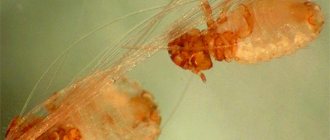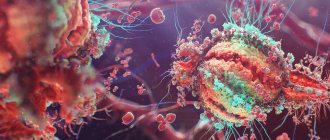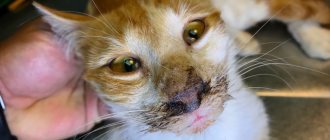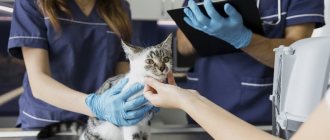Viral infections occur in 80% of stray cats, and among domestic animals this figure is 10-15%. Symptoms of the disease can appear like those of a cold and often do not cause concern to owners.
As a result, the recovered pet becomes a carrier and source of infection for a long time. Information about the most common viruses, methods of treatment and prevention will help to identify a dangerous disease in a timely manner and save the life of a cat.
What do viral infections have in common?
Unlike other diseases, feline infections of a viral nature have the following complex:
- latent initial period, which can last from several days to several years;
- mass distribution within a building, street, nursery;
- high contagiousness (cats of all ages and breeds get sick);
- increased body temperature (above 39 degrees);
- rapid course (in acute form);
- body intoxication and dehydration.
Only a veterinarian can determine the infection in a laboratory setting. To do this, you will have to take swabs from the nasal cavity, saliva or blood of the animal for analysis.
Many infectious diseases lead to the inevitable death of cats if medical assistance is not provided in a timely manner (the only exception is rabies).
Routes of transmission of viral infection in animals
Infections in cats are characterized by a rapid (sometimes lightning-fast) transmission rate from a sick animal to a healthy one. Most feline viruses are concentrated in the patient's body fluids (saliva, eye and nasal secretions), as well as in vomit and excrement.
Thus, when a sick cat sneezes, the infection spreads throughout the room.
Animals infected with the rabies virus become aggressive and bite. This is how infected saliva enters the blood of another animal. With any contact between two individuals (sniffing, playing, biting, mating), there is a high probability of infection.
Important! Any mass gathering of cats (exhibition, nursery, grooming salon or regular training sessions) carries a potential danger. To reduce the risk of possible viral infection, it is recommended to carry out immunoprophylaxis with complex vaccines annually.
Clinical symptoms of viral infection in animals
In cats, viruses can manifest themselves differently at the onset of the disease, but there are common signs that you need to be aware of:
- decreased activity of the pet (lethargy, apathy, reluctance to play and lack of interest in the owner);
- lack of appetite (the cat may approach food less often or refuse altogether);
- an increase in body temperature of more than 1 degree (in healthy cats, the normal temperature range is considered to be 37.5-39 degrees);
- loose stools (diarrhea with mucus);
- the appearance of signs of a “cold” (sneezing with sputum, watery eyes, frequent licking of the face and front paws).
Treatment methods for infection
Animal infections can be treated only after examination by a veterinarian and an accurate diagnosis based on laboratory tests.
Therapy for most viral infections involves the use of specific immunoglobulins, antiviral and antibacterial drugs, the administration of saline and vitamin solutions, as well as cardiac and respiratory medications.
It is extremely important to provide the animal with rest, decent care, gentle feeding and complete isolation from other animals.
Rabies is one of the most dangerous viruses for which treatment is impractical. Due to the risk of infection to people, such cats are euthanized.
Prevention measures
The most popular and recommended measure for the prevention of viral diseases in cats is annual vaccination. If a vaccinated animal encounters a viral agent, the disease will not develop or will be mild.
Starting from two months of age, healthy kittens must be vaccinated according to the standard scheme developed by Russian veterinarians. Exceptions are made in certain regions with unfavorable conditions for infectious diseases.
Important! 10-14 days before the planned vaccination, deworming is mandatory. If this is neglected (and the cat ends up with parasites in its intestines), then a weak immune response to the vaccine will form. Then even a vaccinated cat can get sick.
The recommended scheme for immunoprophylaxis of cats (with examples of vaccines) looks like this:
| Age of the cat | From what diseases | Examples of vaccines |
| 8-9 weeks | Calicivirus infection | Nobivak Tricat, Leucorifellin, Multifel-4, Fel-o-Vax, Purevax RCP |
| Viral rhinotracheitis | ||
| Panleukopenia (plague) | ||
| Viral Leukemia | Purevax FeLV | |
| 12 weeks | Calicivirus infection | Nobivak Tricat, Leucorifellin, Multifel-4, Fel-o-Vax, Purevax RCP+ Rabies or Quadricat |
| Viral rhinotracheitis | ||
| Panleukopenia (plague) | ||
| Rabies | ||
| Viral Leukemia | Purevax FeLV | |
| 1 year (further annually) | Calicivirus infection | Nobivak Tricat, Leucorifellin, Multifel-4, Fel-o-Vax, Purevax RCP+ Rabies or Quadricat |
| Viral rhinotracheitis | ||
| Panleukopenia (plague) | ||
| Rabies | ||
| Viral Leukemia | Purevax FeLV |
It is recommended that cats who live in a house (apartment) be vaccinated against rabies once every 2 years.
Some owners refuse to vaccinate their cats. They explain this by the fact that the animal is sterilized, never walks on the street, does not interact with its fellow animals, and spends its life in apartment conditions. However, viruses are so insidious that they can penetrate a room on a person’s clothes or shoes and cause the development of the disease.
What are infectious diseases of cats and what can cause them?
To better understand the nature of infectious diseases, it is worth starting with the definition of the term “infection” itself. Infection is the infection of living organisms by microorganisms (bacteria, fungi, protozoa). Accordingly, infectious diseases are a group of diseases caused by the penetration of pathogenic microorganisms, viruses and prions into the body. In order for a pathogenic microbe to cause an infectious disease, it must have virulence, or, moving away from medical terminology, toxicity. That is, the ability to overcome the body’s resistance and exhibit toxic effects.
A distinctive feature of infectious diseases is the presence of an incubation period, that is, the period from the moment of infection until the appearance of the first clinical signs. The duration of this period depends on the method of infection, the type of pathogen and can last from several hours to several years. In other words, it is sometimes impossible for a long time to understand that a cat that has contracted an infection is sick, but sometimes it is quite the opposite - a cat that looked healthy just a few hours ago may now show signs of one or another infectious disease.
The most common microorganisms that cause infections in cats include the following: bacteria, microscopic fungi, viruses, rickettsia, mycoplasma. All of them, by their presence in the animal’s body, can cause significant damage to the latter, this is especially true in the case when the necessary treatment is prescribed late or not prescribed at all.
Infectious panleukopenia
The more well-known name for the disease is feline distemper. A very contagious disease that affects cats of all age categories, however, 3-4 month old kittens are considered the most sensitive.
The infection does not pose a threat to humans or dogs, but it is better to isolate a sick or suspicious kitten and provide it with individual care. The panleukopenia virus is very stable in the external environment and is excreted in feces and vomit.
Therefore, it is important to periodically disinfect all care items (bedding, bowls, scratching posts, litter tray) both during and after treatment. There are special products for this that can be purchased at pet stores.
Methods of infection penetration:
- close contact with a sick animal (breeding, a trip to the country, an exhibition, contact with a stray kitten, a visit to a veterinary clinic);
- with dirty shoes (when you stepped on feces or vomit from a sick cat on the street);
- with other people's scratching posts, beds or houses (if you bring care items from a sick animal into the house).
Characteristic signs of the disease:
- depression, lack of appetite and reluctance to drink water;
- high body temperature (up to 41 degrees);
- emaciation and dehydration;
- shallow and rapid breathing;
- fearfulness and convulsions (with the nervous form of the disease);
- inflammation of the eyes and nose with purulent discharge, bronchitis, shortness of breath and heavy breathing;
- watery stools with mucus and foul odor;
- vomit.
An increase in the listed signs of a viral disease with a simultaneous drop in temperature below normal (37.5 degrees) in a cat poses a threat to life and inevitable death if timely treatment is not started.
Plague therapy consists of the primary administration of antiviral serum (examples of biological products: Vitafel S, Globfel-4). Apply three times, with an interval of 12-24 hours. Then, restorative therapy is carried out to combat dehydration through drip systems (Ringer's solutions, 5% glucose, sodium chloride are administered intravenously).
Broad-spectrum antibiotics (Enrofloxacin, Amoxicillin, Ceftriaxone) are prescribed for a course of 5-7 days. Additional medications include vitamins (water-soluble in a dropper) and means to support the heart and respiration (Sulphocamphocaine).
The disease is dangerous because in kittens the mortality rate reaches 90%. Adult cats that survive the first few days usually recover but remain contagious for 1 year. Therefore, it is so important to carry out frequent general cleaning of the premises and disinfect all animal care items.
Prevention of infections
The most effective prevention of the spread of infectious diseases in cats is timely vaccination. In modern veterinary medicine there are many effective vaccines that can protect your pet from such diseases.
Read in detail the list of required vaccinations: Vaccinations for cats - what, how, why?
In addition to vaccination, cats should not be allowed to roam freely or have contact with potential carriers of infections (wild relatives). It is also worth paying special attention to the cat’s immunity, because it is weakened immunity that is most likely to lead to the animal eventually contracting one or another “infection.” High-quality balanced nutrition, vitamin complexes and a healthy emotional background are the key to success in the fight against various types of infections.
In conclusion, we would like to add: love your pets, be attentive to their health and do not be afraid to contact a specialist once again if there are changes in the cat’s behavior. And if the infection still overtakes your purr, do not give up and fight. Modern veterinary medicine has stepped far forward, and even in the most advanced cases there is always a chance to win!
Coronavirus infection
This name combines two infections: intestinal viral enteritis and infectious peritonitis.
Sources of infection are sick and recently ill cats, especially stray cats. The virus is shed in animal feces.
Intestinal coronavirus is considered a mild disease that does not threaten the cat’s life. Usually accompanied by inflammation in the small intestine in kittens, which leads to indigestion and loose stools.
In 50% of cases, recovery occurs within a week, but within 1-2 months, viral agents will be released in the animal’s excrement, which poses a risk of infection for other cats.
During the period of coronavirus infection, symptomatic treatment is carried out with the administration of immunoglobulins.
Infectious peritonitis (FIP)
IPC develops in approximately 10% of cats that contract coronavirus enteritis. As a result of a mutation of the virus, infectious peritonitis (inflammation of the abdominal cavity) develops in the cat's body.
Symptoms of viral peritonitis:
- in the wet form of the disease, a large amount of fluid accumulates in the chest or abdominal cavities, so the cat takes an unnatural position and breathes heavily;
- weakness, lethargy, low mobility;
- loss of appetite and weight loss;
- temperature rise is possible.
Unfortunately, infectious peritonitis cannot be treated, and animals are doomed to death. To relieve suffering, the veterinarian provides supportive care.
What do you need to know about cat infections?
Infectious diseases in cats often have quite clear symptoms; each has its own clinical picture, however, the main signs are often similar.
It can be:
- lethargic and depressed state
- refusal to eat regardless of the stress factor
- Gastrointestinal disorders (manifested by diarrhea and vomiting)
- increased or decreased body temperature
- unkempt coat, dull, dry and disheveled
- purulent or mucous discharge from the nose, eyes or mouth
- swollen lymph nodes
Particularly dangerous viruses
Panleukopenia
In common parlance it's cat distemper, sir. A very dangerous transient parvovirus infection that primarily affects the gastrointestinal tract with severe bacterial complications.
Not contagious to humans, only dangerous to cats. It is characterized by high mortality, contagiousness and rapid progression, especially in young cats and kittens. Mortality among kittens 2-3 months of age reaches up to 90%.
The incubation period usually lasts from 2 to 14 days. This means that clinical signs of the disease can appear within two weeks after the virus enters the cat's body.
1. Symptoms can be acute or less pronounced:
- lethargy and apathy
- an increase in body temperature to 41C°, and with increasing intoxication of the body, on the contrary, a decreased temperature is observed
- loss of appetite and weight
- painful stomach
- severe, debilitating vomiting
- severe diarrhea, often bloody
- severe dehydration, resulting in rough, dry hair
- leukopenia (a sharp drop in white blood cells)
- sometimes anemia
Also characteristic external signs may be:
- the appearance of a visible third eyelid in the inner corner of the eye.
- a hunched position over a bowl, while the cat cannot eat or drink.
As a rule, symptoms develop suddenly and quickly, so owners may mistakenly consider the onset of this infection to be a sign of poisoning. If you waste time and do not provide qualified assistance to a sick animal, irreversible disorders develop in the body, which lead to death. Rarely, a subclinical (asymptomatic) form of the disease is possible, accompanied by the formation of immunity and self-healing.
Forget about folk recipes - panleukopenia (distemper) cannot be treated with vodka or eggs!
2. Treatment of the acute form of the disease consists of providing symptomatic supportive therapy so that the body can produce a sufficient amount of its own antibodies to neutralize the virus. Maintenance therapy consists of certain antibiotics and antiprotozoal drugs to combat secondary bacterial complications, intravenous nutritional solutions to correct dehydration, vitamin supplements, antiemetics (anti-nausea and vomiting medications), relief of diarrhea, drugs to increase white blood cell counts, hemostatic drugs for bleeding , and much more, depending on the symptoms and severity of the course. In some cases, it is possible to connect immunostimulants and interferon inducers. Sometimes they resort to blood transfusions. The use of serum immunoglobulins is controversial, as these are drugs with unproven effectiveness. Therapy is prescribed and carried out by an experienced veterinarian under the control of the condition and monitoring of the animal’s blood tests! 3. The virus is transmitted through direct oral contact (through the mouth) with an infected cat or with its secretions - feces, urine, saliva, vomit. Can be transmitted through fleas, through contaminated household items and if hygiene is not observed: unwashed hands, clothes, shoes, trays, food and water, dishes, bedding, carrying, wall surfaces, floors, etc., as well as by airborne droplets in as a result of inhaling the virus through the nose with air.
4. Animals that have recovered from the disease acquire lifelong immunity to the virus, but can shed the virus in their feces for several months and be dangerous for unvaccinated cats. Therefore, a recently ill cat can infect her kittens after their colostral (maternal) immunity decreases.
5. The virus is species specific, but cats can become infected with a certain strain of parvovirus from dogs. And dogs can carry feline panleukopenia. Therefore, when parvovirus infection is detected, it is necessary to keep dogs and cats separate.
6. Pregnant cats should not be vaccinated with a “live” vaccine, so as not to infect the kittens in the womb. Abortion, stillbirth, or developmental failure of the kittens may occur.
7. The virus is very resistant to disinfectants and can survive in apartment conditions for up to 1 year. Infection occurs through contact with surfaces on which the virus remains.
8. Only vaccinated animals can be placed in an infected premises. Quarantine must be carried out strictly in a separate safe room, which can be easily disinfected and prevent the transmission of the virus on oneself or household items (preferably in a hospital hospital).
9. There is no seasonality of the disease; peaks of the disease are associated with the dynamics of the birth rate of kittens.
10. Vaccination with a complex vaccine is the only method of preventing feline panleukopenia, but no vaccine provides a 100% guarantee. Therefore, it is necessary to avoid self-walking, contact with unknown and sick cats, and keep the house clean. Stronger immunity is created by live (attenuated) vaccines. Only healthy cats can be vaccinated!
Diagnostic methods and results
PCR is considered the main method used for diagnosing panleukopenia. But it can capture the genome of even a non-living virus and its “fragments”, which can lead to errors in diagnosis. In addition, PCR tests, as a rule, take up to 3 days to prepare, and sometimes the result needs to be known on the spot, especially for kittens. However, the results are deciphered as follows:
- positive fecal PCR or rectal wash - the cat may have recently been vaccinated, may have already had the disease and continues to shed the virus, or clinical symptoms are about to begin. In any case, with such an analysis result, the cat is considered dangerous to unvaccinated relatives. Careful monitoring of the condition is required to provide timely assistance and isolation for quarantine. If there is no clinical picture, retake the test in a couple of weeks.
- positive blood PCR (rarely used) – the virus is in the body, careful monitoring of the animal’s condition is required to provide timely assistance and isolation for quarantine. If there is no clinical picture, retake the test in a couple of weeks.
- ICA (immunochromatographic analysis) is a rapid diagnostic test for the antigen titer corresponding to the pathology, that is, a positive result indicates the amount of live virus characteristic of the active form of the disease. Often, during diagnosis, express ICA + PCR (rectal wash) is combined for a more accurate and quick result; this is especially important for kittens, so as not to waste precious time.
- ELISA (enzyme-linked immunosorbent assay) - determines the level of antibody titer to the virus. It may show false positive results if the animal has immunity to the virus, for example, it has recently been vaccinated or has had panleukopenia.
- Negative results may be obtained during the incubation period (that is, during the quarantine period) and may be false negative. Negative tests with obvious clinical symptoms may be a mistake, or it is necessary to exclude differential (with similar symptoms) diagnoses, for example, poisoning, foreign body, severe helminthic infestation, leukemia, etc.
Feline viral leukemia
FLV, feline leukemia. A sluggish oncogenic retroviral infection that affects the bone marrow and, as a consequence, other body systems. Not contagious to humans, only dangerous to cats. According to foreign statistics, about 1% of domestic and 8% of street cats are infected; perhaps in Russia this figure is higher. The virus has not been fully studied, so the disease is very insidious and mysterious.
The incubation period ranges from a week to a month, depending on the cat's immunity. That is, approximately 4 weeks after infection, the virus appears in the blood. This moment is called viremia. Therefore, it is necessary to re-test cats for FLV after the end of quarantine and if there is a risk of infection. 1. Risk groups include:
- age: young cats and kittens are more vulnerable
- free access for the cat to the street and an uncontrolled circle of her communication and sexual contacts
- Unneutered free-roaming cats are very susceptible, as they fight for territory
- crowded keeping of large populations of cats with their constant direct contact - shelters, nurseries
- use for procreation with different females and males
2. Not every cat will become infected after exposure to the virus. If the cat does become infected, then leukemia in the initial stage lasts from 2 weeks to 4 months and occurs in a latent form, or is characterized by nonspecific symptoms. These include:
- increase in body temperature
- loss of appetite and weight
- lethargy
- swollen lymph nodes
Further, the disease has 3 development options:
- Abortive form (temporary viremia) - 20-30% of cases. In this case, the virus remains in saliva and blood for a short time (several months), then immunity to the virus develops and it is completely eliminated (from the Latin elimino - disposal, expulsion) from the body.
- Progressive (constant viremia) - 30-40% of cases. In this case, the virus remains in the blood and saliva for a long time (more than 16 weeks). Immunity to the virus does not develop, the disease progresses and the cat dies from concomitant diseases associated with VLK within a few months.
- Regressive (latent viremia) - 30-40% of cases. The virus disappears from the blood and saliva, but remains in the spleen, lymph nodes, and bone marrow. That is, the animal remains an asymptomatic carrier, sometimes for many years. However, in approximately 10% of these cats, the virus is reactivated due to decreased immunity, especially due to stress factors: changes or unfavorable living conditions, hypothermia, moving, renovations, new family members, etc. And symptoms of leukemia develop.
3. Clinical signs of leukemia are very varied and may not be associated with leukemia at all, which can significantly complicate diagnosis.
The virus has different strains and 3 main forms of influence on the body, which lead to:
- development of oncological diseases - various tumors, lymphosarcoma, etc.
- destruction of the bone marrow, and, as a consequence, the hematopoietic system (severe anemia, leukopenia, thrombocytopenia, etc.)
- destruction of the immune system, which is complicated by secondary infections and autoimmune reactions. From which chronic diseases of the respiratory system, mouth and gums, genitourinary system, gastrointestinal tract, reproductive diseases, parasitic skin diseases, and other systemic diseases such as feline infectious peritonitis often develop.
4. A large amount of the virus is present in the saliva of a sick cat, blood, in addition, the virus can be found in the feces, urine and milk of a nursing cat. The feline leukemia virus is unstable in the external environment and is easily destroyed by disinfectants, treatment with soap solutions, quickly dies when dried or heated, but can persist for some time in liquids.
5. The virus is transmitted only through close direct contact: through saliva during fights, licking, using shared bowls, litter trays, mating, contact with biological fluids of a sick cat, and transfusion of infected blood. Kittens almost always become infected from their mother - during childbirth, when the mother bites the umbilical cord, and also through milk. Infection from the mother in utero is questionable.
6. So far, no medicine has been found that will rid the body of the virus, but experimental drugs are used to inhibit the development of the virus. There is no single effective treatment for cats infected with FLV. Thus, treatment is symptomatic and aimed at eliminating clinical symptoms, secondary infections, improving well-being and preventing the spread of the virus in the body and to other cats. In no case should you use immunomodulators or immunostimulants on your own, as this can aggravate the course and speed of development of the disease.
7. Separate keeping of healthy and sick cats, including carriers of the virus, is required. It is unacceptable to let cats with VLK go outside. A cat with VLK should be the only cat in the house. It is not advisable to adopt a cat also suffering from FLV, since the strains of the virus are not determined and this can aggravate the disease.
8. The need for vaccination against leukemia often causes controversy among specialists. The VLK vaccine is an additional vaccine. Its use should be determined by the risk-benefit ratio. It is necessary to take into account the cat’s lifestyle and the risks of infection: does it go outside, is it used for reproduction, does it live in crowded conditions with a changing pride composition. Only animals without FLV in the body can be vaccinated.
General recommendations
The most important thing for cats with this disease, as in general, is good maintenance and absence of stress. Good nutrition, care, parasite prevention and no outside walking are necessary. The animal must be exposed to a minimum number of pathogenic microorganisms. Castration of cats with leukemia is necessary, since the stress from the constant production of sex hormones is higher, and the risk of developing cancer is even higher. Complex vaccination with great caution, only with “dead” vaccines, since a “live” vaccine can cause severe complications, while protection from such a vaccine is lower, and the risk of post-vaccination sarcoma is higher. Ideally, such cats should simply always stay at home. Such cats should be strictly limited from other cats, or be the only cats in the house. It is necessary to observe the rules of hygiene in the home. Avoid hypothermia. Visit veterinary clinics only when necessary and for routine tests. At the same time, in the clinic, the cat must always be placed on the table on its own towel or diaper and avoid contact with other animals in line.
Diagnostic methods and results
Leukemia is a very insidious and quite difficult viral infection to diagnose. Therefore, a combination of different laboratory research methods and repeated tests are needed about a month after the tests taken on the first day when you took the cat into quarantine. And in the case of a clinical picture and suspicion of VLK, a comprehensive diagnosis is necessary, which usually includes a general clinical and biochemical analysis of blood, urine, feces, ultrasound, radiography, and sometimes more complex procedures. The use of rapid ELISA tests is recommended.
A positive test for leukemia is NOT an indication for euthanasia!
- IHA - blood. It is considered one of the most reliable methods. A negative result is possible in a healthy animal, with a regressing (latent) form, and in the first 4 weeks of the disease, when the concentration of the virus antigen in the body has not yet reached the required level. A positive result means the animal is infected. If the clinical picture is unclear, the analysis should be repeated after 6 and another 10 weeks. It is extremely rare to have false positive results. In any case, if the result is positive, the cat should be isolated from direct contact with other cats and their household items, or be the only cat in the house. Double-checking by PCR method (RNA+DNA) is required.
- ELISA - blood. It is considered one of the most reliable methods. He has high sensitivity. Captures antibody titer. A positive result may indicate 2 options: the virus was in the body and left an immune trace. The virus is in the body at the moment and the immune system is actively responding to the virus. A negative result can have 2 interpretations: the test was taken too early (during the incubation period) and the body has not yet had time to respond to the presence of the virus. The virus is in the body in an active stage, but the immune system is not able to respond to it. Double-checking by PCR method (RNA+DNA) is required.
- RNA PCR - saliva, blood. A highly sensitive method used in the early stages of the disease. Capable of catching the virus when it has not yet integrated into the DNA of the host cell. At the same time, positive RNA also indicates the active reproduction of the built-in virus and the further development of the disease must be diagnosed several more times at intervals of 6 and 10 weeks. If PCR RNA is not detected in the blood, this does not indicate the absence of the virus in the body. Not available in all laboratories. It is useful to combine with DNA PCR + ICA/ELISA.
- DNA PCR - blood. Highly sensitive method. A positive result indicates that the virus has integrated into the DNA of the host cell. Further development of the disease must be diagnosed several more times at intervals of 6 and 10 weeks. In this case, false positive and false negative results may occur. However, if the result is positive, the cat should be isolated from direct contact with other cats and their household items, or be the only cat in the house. If the PCR is negative, but the clinical picture corresponds to the disease, an ICA is additionally taken. It is useful to combine with RNA PCR + ICA/ELISA.
- Viral load is used to assess the concentration of the virus itself in the blood. Causes controversial opinions among experts. Interpreted using conventional laboratory values.
Feline immunodeficiency virus
FIV, feline HIV. A sluggish retroviral infection that affects the immune system. Not contagious to humans, only dangerous to cats. The infection is in many ways similar in course to human HIV. Unlike the feline leukemia virus, carriage of the immunodeficiency virus is lifelong. But the virus is much less aggressive. According to foreign statistics, the prevalence rate among clinically healthy cats is approximately 2%, in clinically sick cats from 14% to 30%. In Russia these numbers may be higher. The virus is also not fully understood.
The incubation period after infection is usually about a month and for about another month the body produces antibodies that can be detected in the blood. That is, approximately 2 months after infection. Therefore, it is necessary to retest FIV tests for cats that have been at risk of infection.
1. Risk groups include:
- age: young cats and kittens are more vulnerable
- free access for the cat to the street and an uncontrolled circle of her communication and sexual contacts
- Unneutered free-roaming cats are very susceptible, as they fight for territory
- crowded keeping of large populations of cats with their constant direct contact - shelters, nurseries
- use for procreation with different females and males
2. Most symptoms of viral immunodeficiency are not directly related to the virus, and are often completely absent. The first signs of the disease can have varying degrees of severity. These include:
- increase in body temperature
- loss of appetite and weight
- lethargy
- swollen lymph nodes The cat may then go months or years without symptoms associated with the infection. This is due to the strong immunity of the animal, and in some cases the asymptomatic period continues in infected pets throughout their lives. As the disease progresses, the immune response is suppressed and secondary infections appear, which often recur:
- oral diseases
- respiratory diseases
- fungal and parasitic skin infections
- gastrointestinal disorders
- cystitis
- otitis
- eye lesions
- enlarged spleen
- swollen lymph nodes
- neurological disorders
- neoplasms and lymphomas - uncommon
- Leukopenia, lymphopenia, anemia, neutropenia, etc. are observed in the blood.
3. The virus is transmitted only through close direct contact: through saliva during fights, licking, when using shared bowls, litter trays, possibly during mating, through contact with the biological fluids of a sick cat, through an infected blood transfusion.
Kittens do not always become infected from their mother. They may not become infected at all, or not all kittens may become infected. But an FIV-infected cat or tom must be removed from breeding. Infection occurs during childbirth, when the mother bites the umbilical cord, and also through milk. Infection from the mother in utero is questionable. 4. The virus is contained in the blood, saliva, milk and other biological fluids of a sick animal. The virus is unstable in the external environment and does not tolerate direct sunlight and drying; it is easily destroyed by all known antiseptics, even soap solution.
5. Kittens from infected cats receive colostral antibodies through their milk and may give false-positive antibody test results for up to 6 months. Therefore, a kitten with positive antibody results should have the test repeated after 6 months. If the positive result remains at six months of age, the kitten is infected.
6. Treatment is mainly aimed at maintaining immunity and general body tone in order to prolong the active life of a sick cat as long as possible. Therapy for feline viral immunodeficiency, like therapy for leukemia, includes symptomatic treatment, suppression of secondary microflora, treatment of concomitant diseases and suppression of virus replication in the blood. In no case should you use immunomodulators or immunostimulants on your own, as this can aggravate the course and speed of development of the disease.
7. Separate keeping of healthy and sick cats, including carriers of the virus, is required. Letting cats with FIV outside is unacceptable. A cat with FIV should be the only cat in the house. It is not advisable to adopt a cat who is also sick with FIV, since the strains of the virus are not determined and this can aggravate the disease.
8. The FIV vaccine is not available in Russia. It is also considered additional and its use should be determined by the risk-benefit ratio and only in FIV-free cats.
General recommendations
The most important thing for cats with this disease, as in general, is good maintenance and absence of stress. Good nutrition, care, parasite prevention and no outside walking are necessary. The animal must be exposed to a minimum number of pathogenic microorganisms. Castration of cats with immunodeficiency is necessary, since the stress from the constant production of sex hormones is higher. Complex vaccination with great caution, only with “dead” vaccines, since a “live” vaccine can cause severe complications, while protection from such a vaccine is lower, and the risk of post-vaccination sarcoma is higher. Ideally, such cats should simply always stay at home. Such cats should be strictly limited from other cats, or be the only cats in the house. It is necessary to observe the rules of hygiene in the home. Avoid hypothermia. Visit veterinary clinics only when necessary and for routine tests. At the same time, in the clinic, the cat must always be placed on the table on its own towel or diaper and avoid contact with other animals in line.
Diagnostic methods and results
Unlike the leukemia virus, when you need to look for the virus itself, when diagnosing immunodeficiency it is necessary to look for antibodies to the virus. Antibodies may not be detected in 2 cases - the incubation period has not yet passed and antibodies have not yet developed, or the sick animal is in a very serious condition, when the immune system can no longer produce antibodies. Cats from the street or from catteries must be retested for FIV 2 months after the first negative results. Kittens under 6 months of age may have false positive antibody test results. In rare cases, false positive results occur in healthy animals, so if there are no other signs of disease, the test must be repeated. General diagnosis of FIV includes a general clinical and biochemical analysis of blood, urine, feces, ultrasound, etc. The use of rapid ELISA tests is recommended.
A positive test for immunodeficiency is NOT an indication for euthanasia!
ELISA, ICA blood - if there are traces of an immune response in the blood, it means that the animal has been in contact with the virus and is 100% infected. It requires lifelong maintenance therapy and should be kept separately from its relatives.
PCR should be used in cases where an animal suspected of immunodeficiency has negative antibody test results.
Note
There is a combined enzyme-linked immunosorbent method (SNAP test), which immediately shows the result for both FIV and VLK. This option is in some cases much more convenient, and also cheaper than separate tests for each virus.
Coronavirus
A virus that is widespread in the population: the presence of antibodies is detected in 50% of domestic cats and in 90% of cats in shelters and nurseries. Perhaps the most harmless of all sluggish viruses. Many doctors have come to the conclusion that this virus is permanently present in most cats and the vast majority of them live a wonderful life with it, without showing it in any way.
1. Risk factor – crowded content.
2. Species-specific - does not pose a danger to humans and animals of other species.
3. The virus can leave the body when the overall infectious load is reduced (single housing, regular cleaning of the tray, lack of stress, care, maintaining the gastrointestinal tract in good condition - good nutrition, absence of parasites) or for other reasons.
4. A cat can be a carrier of the virus all its life without having any manifestations.
5. Routes of transmission: fecal-oral (common tray and bowls with an infected animal).
6. In rare cases (about 5% of all permanent carriers of the virus) it can mutate into a fatal disease (FIP). A risk factor is any stress.
7. It is undesirable to keep healthy and infected animals together in the same space.
Symptoms: in rare cases, diarrhea, vomiting. It may appear once in a lifetime, or occur periodically, or may become severe with a poor prognosis. But these symptoms have a huge number of other causes, which are often completely unrelated to the coronavirus.
Diagnostic methods and results
- Antibody detection/ELISA will show whether the cat has been in contact with the virus. A positive test and high titers - you need to retake it after 2-3 months. A negative test can sometimes be false, so it is also better to repeat it (you don’t need to wait long, but you can take it in another trusted laboratory, or on another day on the same day).
- Positive fecal PCR – the cat is shedding the virus and can now infect other cats.
- Until the situation is clarified, in both cases the animal must be quarantined without its relatives.
Respiratory viruses
Feline calicivirus infection
.
A highly contagious infection of the upper respiratory tract, in severe form it is a systemic disease, long-term carriage is possible.
1. The virus is widespread; when kept in crowded conditions, it affects up to 90% of the population.
2. Species-specific - there is no danger of infection of other species of animals and humans.
3. The virus is transmitted through secretions from the upper respiratory tract (respiratory form) or through any secretions through the skin (systemic form), as well as through hands, clothing, various surfaces, fleas and their feces.
4. Stable in apartment conditions for up to 28 days.
5. The virus mutates very often, so vaccination in most cases only helps to alleviate the course of the disease. Superinfections may occur that the vaccine does not protect against.
6. The virus is released into the external environment within 30 days, but some cats become carriers for life.
Symptoms appear 2-10 days after infection: sneezing, blisters or sores in the mouth, on the nose, excessive drooling, runny nose, fever, lethargy.
Diagnostic methods and results:
PCR diagnostics (nasal washes, oropharynx, etc.) - can sometimes be ineffective due to frequent mutation of the virus. The results are assessed by the doctor in the context of the clinical picture. Confirmation that the cat has stopped shedding the virus - 3 negative results at seven-day intervals.
So, we have listed the main and most dangerous cat infections that every volunteer should be familiar with. Without understanding the risks, there is a high probability of causing trouble, even if you have the best intentions.
After or before assessing the external condition, thermometry is performed (normal temperature in cats is 38-39 C). In addition, pay attention to appetite, breathing patterns, the color of the mucous membranes of the mouth and eyes (normally they are pale pink, cyanosis and yellowness should alert you); as well as the color, consistency and even the smell of natural feces: urine and feces - normally they do not contain impurities of pus, blood, or foreign inclusions. Further actions will depend on the results of the examination: At the slightest suspicion of a serious illness (fever, poor appetite, dull coat, disheveled hair, depression, dry and hot nose), find a way to consult a veterinarian. If, according to external signs, everything is more or less normal, then you can proceed to the next stage of introducing the cat into a new comfortable life.
Diagnostic comment:
The doctor always compares the clinical picture and the results of laboratory tests.
But not a single laboratory diagnostic method gives a 100% guarantee of the absence or presence of the virus in the body. Firstly, viruses are quite complex organisms and sometimes may not appear in the blood or body fluids, especially for indolent viruses.
Secondly, laboratories examine only a specific sample of material and errors sometimes occur. Plus the human factor, hardware contagiousness, and the quality of laboratory reagents and drugs must be at the highest level.
Therefore, tests often need to be repeated for double-checking.
Mistakes happen in any laboratory, but always choose more reliable laboratories that have been on the market for these services for many years and have good equipment and reviews, the necessary certificates and qualified personnel.
Also listen to the advice of experienced volunteers.
Over time, you will begin to understand this more accurately. It is imperative to get tested! But there is no need to panic if some positive result comes.
Herpes virus infection (feline rhinotracheitis)
Herpes viral rhinotracheitis is often confused with a cold due to the similarity of symptoms (coughing, sneezing, mucous discharge from the nose and eyes, poor appetite). This common disease occurs everywhere where cats live in crowded conditions and are not vaccinated (shelters, basements, nurseries from unscrupulous breeders).
The source of the viral infection is a sick cat. Infection occurs through direct contact of animals with each other. The virus is concentrated in discharge from the eyes, nose, and is present in feces, urine and semen, as well as in utero.
Feline herpesvirus rhinotracheitis is highly treatable.
Rules for helping a sick cat:
- provide the animal with rest (in a warm, dry room, separate from other pets);
- regularly feed the cat with a syringe;
- clean the nasal passages and eyes from discharge with a damp swab;
- If a cat refuses food for 3 days, you need to force-feed him soft food;
Drug treatment of herpes includes the use of:
- serum with ready-made antibodies in the first 3 days of treatment (Vitafel, Globfel);
- broad-spectrum antibiotics, since the development of a secondary infection is likely (Ceftriaxone, Amoxicillin, Enrofloxacin);
- vitamin solutions in injections (Catozal, Gamavit);
- eye drops (0.25% Levomycetin);
Important! Some clinics practice prescribing antiviral drugs with unproven effectiveness for feline herpes (Fosprenil, Anandin, Maksidin, Immunofan). Sometimes the prescription list includes hormonal drugs to relieve swelling of the animal’s nasopharynx (Dexamethasone, Prednisolone). The veterinarian prescribes these medications at his own discretion, depending on the severity of the animal’s condition.
Bacterial and fungal infections
The most common bacterial infections in cats are infectious anemia and salmonellosis. With the first, elevated temperature, lethargy, refusal to eat, and pallor of the oral mucosa are observed, and with salmonellosis, vomiting and runny nose are added to the above symptoms. Treatment of these infections in cats occurs through the use of antibiotics, homeopathic medicines, and hyperimmune serums.
There are a lot of fungal infections that our pets can be exposed to. Such pathologies affect the external and internal organs of the animal. The most common among them are histoplasmosis, candidiasis and cryptococcosis. Infection occurs through contact with fungal spores - through a wound, during food intake or through the air.
Read more: What are fungal diseases in cats?
As we see, there are many infectious diseases and not all of them are treatable. Therefore, only a doctor can identify what kind of infection the pet has been exposed to, as well as prescribe the correct therapy. The task of the animal owner is to immediately contact a veterinary clinic if the slightest symptoms of the disease appear in a tailed family member.
Calicivirus infection
Calicivirus is a feline infection of a viral nature, with clinical manifestations similar to herpes (sneezing, discharge from the eyes and nose, crusts, loss of appetite). A characteristic difference is the presence of ulcers on the cat’s tongue.
The direct source of infection are street kittens and adult stray cats that have become ill but remain carriers of the virus. Even in the absence of direct contact between domestic cats and street cats, viral particles enter the house on the owner’s shoes, and the pets become ill with calicivirus.
Treatment and prevention of this disease are similar to infectious viral rhinotracheitis.
Viral leukemia
Viral leukemia (leukemia) of cats is a chronic disease of a viral nature. Accompanied by a weakening of the body's defenses, pathological neoplasms (multiple lymphosarcoma) and the development of anemia.
Leukemia in a latent form can remain in the animal’s body for several years, and when the immune system is weakened, it is activated and spreads throughout the body.
Kittens and weakened cats are susceptible to infection. There is no risk of infection for humans or other animals.
Routes of entry of viral leukemia:
- direct contact of two animals (saliva, nasal discharge, excrement, with mother's milk, during mating);
- intrauterine;
- during blood transfusion.
Feline viral leukemia is difficult to identify because at first the symptoms are identical to infections of the digestive system (weight loss, lack of appetite, anemia).
Next, neoplasms develop in the lymph nodes, vomiting, diarrhea with blood, inflammation of the eyes, and unsteadiness of gait appear, leading to paralysis of the pelvic limbs.
In pregnant cats, the offspring die in utero or for the first time days after birth (due to anemia). Often secondary diseases are added to leukemia due to the lack of resistance to infections, which is why laboratory diagnostics can reveal several infectious diseases in one animal.
There is no specific treatment for feline viral leukemia. Basic therapy involves alleviating the animal’s condition and increasing life expectancy. Chemotherapy of formations and concomitant treatment is prescribed individually, according to indications. Measures must be taken to prevent the spread of the disease.
The optimal way to protect a cat from this infection is annual vaccination (Leucocel or Purevax FeLV), which is especially important for breeders of rare breeds.
For prevention in nurseries, hotels and veterinary clinics, it is recommended to frequently wash bedding in hot water (at least 60 degrees), since the virus is inactivated at high temperatures.
Are all cats susceptible to infections: risk factors
Experts are often asked whether all animals are at risk of contracting infectious diseases? Unfortunately, practice shows that cats with 100% immunity to all infectious diseases do not exist. This means that the presence of one or more risk factors is likely to lead to the animal getting sick. Such factors include crowded housing of cats that does not meet zoohygienic standards, poor quality food, and contact with a sick animal or hidden microbial carrier. Stress is also an important risk factor - it is stress that weakens the pet’s immunity and makes the cat susceptible to various types of infections. In other words, any factors that negatively affect its condition can increase a cat’s susceptibility to infections, thereby weakening the animal’s body.
Modern medicine has revealed that a kitten can catch an infection in a variety of ways: through damaged outer skin, the digestive tract, and the respiratory tract. The most dangerous route of spread is direct, direct contact between a susceptible animal and a sick animal. Infectious diseases are also transmitted through the air. Therefore, it is extremely important to monitor your pet’s condition and protect it from possible risk factors, thereby reducing the likelihood of disease.
Viral immunodeficiency (FIV, FIV)
This is an infectious chronic disease of cats with irreversible damage to the immune system and high mortality. The virus is widespread throughout the world due to the lack of specific treatment and developed vaccines.
The main carriers of the infectious disease are adult and elderly cats (over 5 years old). The virus is transmitted through animal bites (saliva, blood), as well as through mutual licking of cats.
Symptoms of the development of viral immunodeficiency are similar to leukemia:
- decreased activity in a sick pet;
- low appetite and weight loss;
- persistent diarrhea;
- inflammatory diseases of the oral cavity;
- neoplasms in the lymphatic system;
- superimposition of secondary infections.
If a sick cat is diagnosed with Viral Immunodeficiency, the pet should be isolated and given symptomatic treatment using immunomodulators. You also need to avoid contact with healthy cats.
Expert opinion
Chepa Natalya Semenovna
Veterinarian
Ask an expert
Infected animals are recommended to be kept at home without walking, castrated, and fed with industrial feed to eliminate the risk of contracting infections through raw meat or fish. If your animal is diagnosed with FIV, but its general condition is satisfactory, and the examination did not show any abnormalities, then the pet has every chance of living a long life. It is necessary to take blood tests (clinical and biochemical) and a general urine test once every six months, as well as an abdominal ultrasound and chest x-ray once a year. Sick cats are not recommended to use drugs that suppress the body's immune system, only if there is a confirmed diagnosis requiring such therapy.










